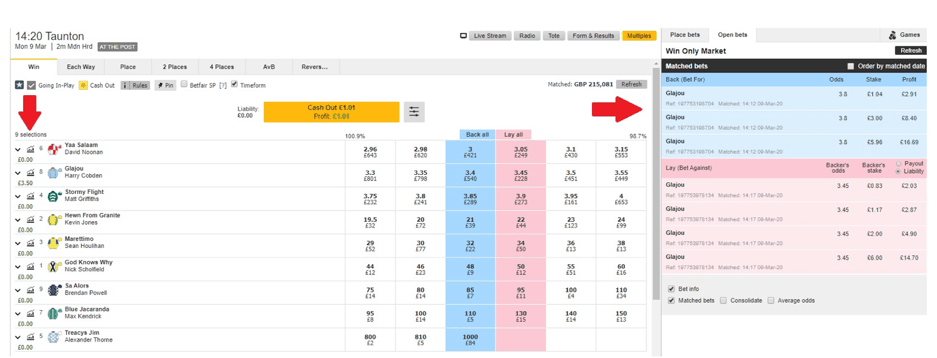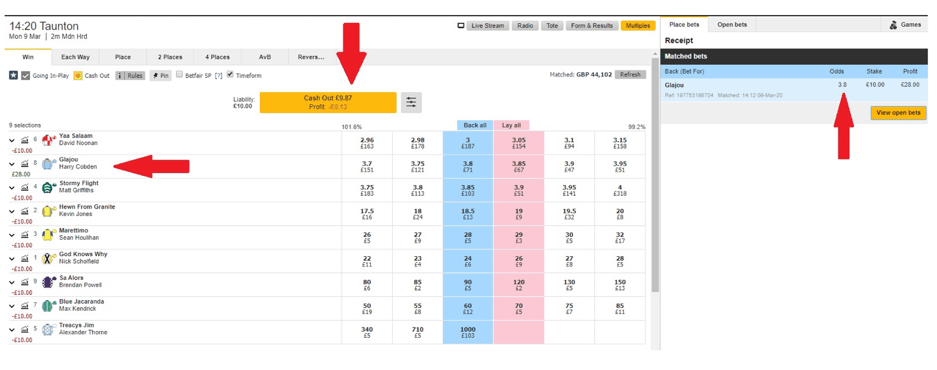
What Causes Betting Odds To Move
Is the Price Right? What Causes Odds Movements?
For decades, sports betting involved placing a wager on an event. Your only option was to make a ‘straight’ bet, and if it won, you got your winnings. If it lost, you got nothing. Upon the launch of the Betfair Exchange approximately two decades ago, everything changed. It became possible to place ‘back’ and ‘lay’ bets.
In the intervening years, this process of trading is incredibly popular. It provides the opportunity to make a guaranteed profit without risking your entire stake. Savvy traders know when a price is set to rise or fall. Then, they can make a low-risk profit. Do this 100 times in a week, and it adds up fast!

In this example, I placed a £10 back bet on Glajou at odds of 3.80 in the belief that his price would fall.

Sure enough, the horse’s odds plummeted to 3.40 and eventually as low as 3.25 the last time I checked. I decided to place a £10 lay bet at odds of 3.45. I could cash out for £1 or allow the race to proceed and win £3.50 if Glajou wins, and lose nothing if he doesn’t. The process of trading has altered the sports betting landscape, but how do traders know when a price will rise or fall?
Let’s find out!
Odds Movements in General
One of the most significant factors that alter the odds is the Weight of Money (WOM). In general, the more money placed on an outcome, the shorter the price becomes. After all, bookmakers need to balance their liabilities. If a bookmaker receives £300,000 worth of bets on a horse to win, he is foolish not to take action and cut the odds, while also finding a way to balance his books if the horse ultimately wins.
A market has to be set for every single sport betting market in the beginning. Bookmakers tend to include factors such as the form of the participants, where the WOM is likely to go, and the general conditions. If Barcelona announces an injury to Lionel Messi, for example, the bookmakers will change the odds at the beginning of the market in the knowledge that punters will likely bet against Barcelona more often than they otherwise would.
An example occurred in the FA Cup in January 2020 after Liverpool manager, Jurgen Klopp, made no secret of his dissatisfaction with the scheduling. When the initial third round draw was made and paired Liverpool against Everton at Anfield, the market placed the Blues as decided underdogs.
Once it became clear that Klopp would field an inexperienced side, Everton’s odds plummeted, and they were almost 2.00 at kick-off. Had you backed to lay, the fact that the away side lost didn’t matter!
Market confidence also plays a big role in the odds’ movement. Uncertainty leads to weak value prices with bookmakers, low liquidity, and large spreads. Those who try to bet on summer leagues on the Exchange (when you can find the games) will see these facts illustrated in full.
As the event draws nearer, much of the uncertainty is dismissed as a higher number of unknowns become known. This results in more confidence, and savvy punters add some volume to the market. A bookmaker confident in his reading of the market may keep his price the same. However, as his rivals make the switch, he risks leaving himself exposed. Let’s say Bookie X keeps his price at 1.70, and his rivals bring it in 1.40, Bookie X will likely receive a lot of wagers and faces a nervous wait.
What About Football?
Pre-match odds movements are usually down to factors such as team news, injuries, and a team’s recent form. Followers of MLS also know that the vast journeys faced by away sides have a significant effect on the market. Football traders often suggest that in-play action is akin to a 90-minute stock market.
The most obvious reasons for in-play odds movements are goals, injuries, and red cards. However, bookmakers, and the Exchanges, may alter the odds if one side is unexpectedly dominating the game.
Football traders have a multitude of possible ‘angles’ to choose from, including:
- Back or lay the draw.
- Over/under goals.
- Home or away win.
- Half time result.
Experienced traders also know a few tricks of the trade. For example, they know that more goals are scored in the second half of matches. They can back the ‘unders’ goals markets and cash out if the game is low-scoring at half-time. It is normal for the odds on a 0-0 at half-time to be one-third of what they were at kick-off. As the game ticks towards the last 15 minutes with no goal, the odds on a scoreless draw begin to fall more rapidly.
If a heavy favourite is losing a game early on, you can quickly back them if they look as if they will equalise. Also, the odds on the Betfair Exchange go a little crazy after a goal, keep an eye on the market to see what happens. Perhaps you will see a brief opening!
What Causes Price Movements in Horse Racing?
It is always riskier to trade horse racing in-play than football. In a 5f sprint, for example, the race lasts less than a minute. If you back a horse that starts poorly, you will lose most, if not all, of your stake, for example. Likewise, you lose the lot if a horse falls in a National Hunt race. Automation is essential for in-play horse racing trading.
Otherwise, you should look at the pre-race markets. If a high-profile tipster suggests that a horse will win a race, punters usually back the selection and cause the price to fall quickly. The longer odds and huge potential liability in horse racing means that bookies must react immediately.
What experts realise is that morning odds are incredibly misleading and are seldom available for long. Occasionally, you will see a horse go from 22.00 to say 9.00 without any basis. There is also insider betting to consider, which can also cause massive price drops in a hurry. Punters react to the ‘Going’ as well. Given the changeability of Irish and British weather, it is possible for the ground to change markedly overnight. What was suitable for a horse the night before is now bad news.
In the earlier example, I believed that Glajou’s price would fall due to WOM. I saw that large sums of money were already wagered on the horse, and that process would continue. I was proved right in that instance. If you see a 7-horse race, for example, where 40% of the money is wagered on a clear favourite, the price will likely fall. Pay special attention to the last 10 minutes before the race. This is the period when vast sums of money are wagered.
One final point: Take note of races with recently announced non-runners. If the horse in question were the favourite, it would probably cause significant changes to the market.
Related posts:

Jon is the Founder and Chief Tipster at Football Advisor and Predictoloy. He started life as data analyst in the digital marketing field before find his true calling in the world of Football and Horse Racing Betting.
Jon has been sharing his professional expertise since 2009 and specialises in using objective data analysis and subjective experience of betting built up over more than a decade of professional betting.
In 2014, Jon also launched (and continues to run) the trusted Football Advisor service service which provides a variety of football and horse racing betting models and portfolios. A few years later, Jon launched the Predictology platform which is the worlds first betting system builder and analyser covering a wealth of football betting related statistics covering more than 200,000 matches.
Jon has also lent his knowledge and expertise to several of the trusted Premium Services offered by the respected Secret Betting Club, including Football Lay Profits. Racing Bet Profits and, most recently, Racing Lay Profits.